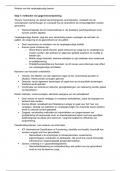Other
Human Rights Case study note A level geography OCR
- Module
- Human Rights
- Institution
- OCR
Three case studies for the OCR geography A-level Human Rights section of the course - includes: strategies for global governance of human rights in Afghanistan, an area of conflict. Women's rights in india. the impact of global governance of human rights in Honduras, an LIDC.
[Show more]












